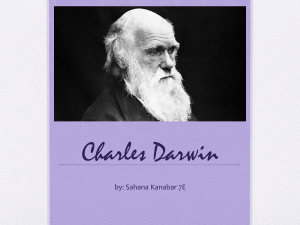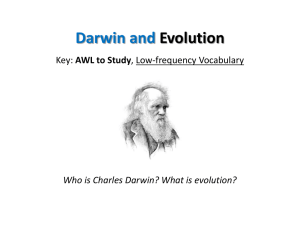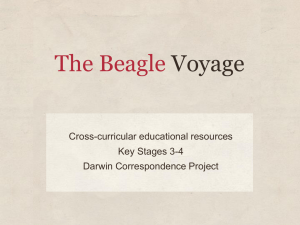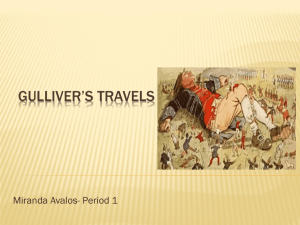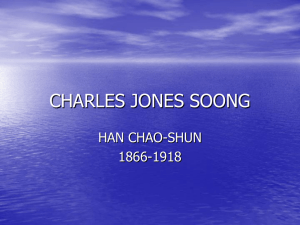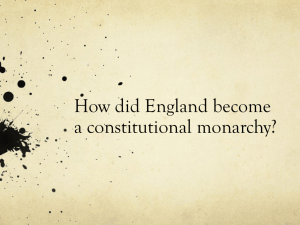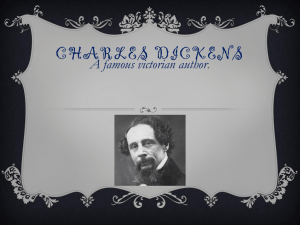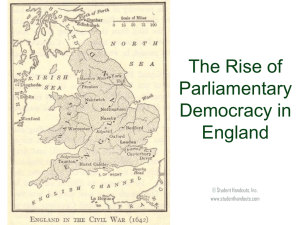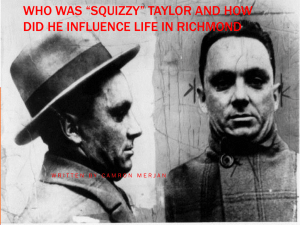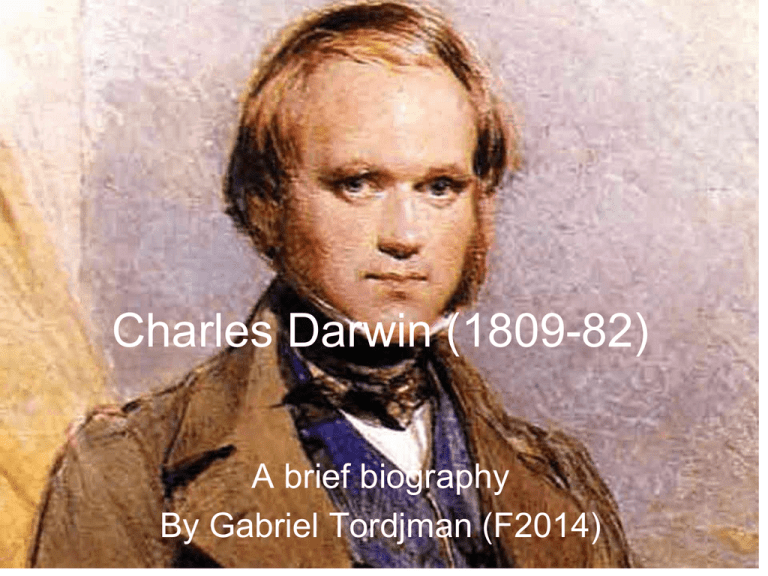
Charles Darwin (1809-82)
A brief biography
By Gabriel Tordjman (F2014)
Early Years
Darwin was born in the little town
of Shrewsbury, England, 12
February 1809.
Here he is at the age of 7. As
you can see, he was interested
in plants (and animals) from the
youngest age.
Early Years
His grandfather, Erasmus
Darwin had already
speculated about evolution
His father, Robert Darwin,
was a doctor and his
mother Susannah died
when he was 8.
Early Years
• At first Charles pursued medical studies at Edinburgh, Scotland but he
found it boring and gruesome. He could not stand the sight of blood.
• His father then signed him up at Cambridge for a Bachelor’s program in
preparation for a career as a parson.
http://springwoodgcsehistory.blogspot.ca/2010/08/nineteenth-century-surgery.html
Early Years
Christ’s College Cambridge where Darwin studied for a few years. He spent
much of the time learning about natural history and natural theology.
Early Years
HMS Beagle in the
Straits of Magellan
http://en.wikipedia.org/wiki/HMS_Be
agle#mediaviewer/File:PSM_V57_D
097_Hms_beagle_in_the_straits_of
_magellan.png
•
•
Suddenly, Darwin was offered a 5 year trip around the world to be the naturalist aboard the
HMS Beagle.
After friends convinced his father, he began the epic trip that would change the world in 1831.
The Voyage of The Beagle
Captain Robert Fitzroy, RN (180565) of the HMS Beagle.
He accepted Darwin as naturalist
on board the ship and gave him a
copy of Lyell’s Principles of
Geology but was bitterly
depressed and felt guilty after
Darwin published Origin in 1859.
In 1865 he committed suicide,
leaving a wife and two children.
The Voyage of The Beagle
The HMS Beagle entering Tierra del Fuego
The Voyage of The Beagle
Voyage of The
Beagle
Some of the natives of Tierra del
Fuego (southern tip of South
America) Captain Fitzroy had
encountered on his first voyage to
South America.
Darwin was shocked at the
“primitiveness” of the people.
(Contrast this to A.R. Wallace’s
admiration of the natives of Brazil).
Fitzroy had some brought back to
“civilize” and “Christianize” them.
http://www.darwinproject.ac.uk/wp-content/uploads/2013/03/Fuegians.jpg
The Voyage of The Beagle
•
•
•
•
Darwin approaching
Charles Island,
Galapagos (above).
Various shell shapes
of tortoises on
various Galapagos
Islands lead Darwin
to natural selection
theory (amongst
other evidence).
Prints by Simon Gurr
https://simongurr.wordpress.co
m/category/comics/page/6/
Discovering Evolution
Notes from one of Darwin’s
Notebooks during Beagle
voyage and his first evolutionary
tree.Notice the “I think” at the
top.
Darwin saw that big geological
changes had occurred and
realized species had to change
to match this change in
environment.
Discovering Evolution
Upon his return in 1836, he was a confirmed
evolutionist but was still searching to find the
answer to the crucial question of how
evolution happens.
Darwin Naturally
Selects Emma
Meanwhile, he meets Emma Wedgwood
and naturally selects her as a possible
wife.
Like the scientist he is, Darwin writes out
the pros and cons of marrying.
Eugene Byrne and Simon Gurr, Darwin: A Graphic Novel.
Retrieved from:
http://www.brainpickings.org/index.php/2013/02/12/darwingraphic-biography-smithsonian/
Darwin Naturally Selects Emma
Darwin’s wife, (and first
cousin) Emma
Wedgewood.
She was a devout
Christian. Darwin was
frank about his ideas on
“transmutation” to her.
Despite this and her
concern that they would
be separated in the
afterlife, she accepted his
proposal.
They married in 1839.
Darwin Naturally Selects Emma
Down House not far from London where Emma and Charles settle down after a brief
time in London.
Darwin Naturally Selects Emma
Darwin’s study at Down House. He conducted numerous experiments in the
gardens and greenhouse and wrote many of his works here.
Discovering Natural Selection
• Already famous for his trip and his
book on it, Darwin continued his
search for a how of evolution and
came upon Malthus’ book, On
Population:
•
In October 1838…I happened to read for
amusement Malthus on Population, and being
well prepared to appreciate the struggle for
existence which everywhere goes on from longcontinued observation of the habits of animals
and plants, it at once struck me that under
these circumstances favourable variations
would tend to be preserved, and unfavourable
ones to be destroyed. The result of this would
be the formation of new species. Here, then, I
had at last got a theory by which to work...
(Darwin, Autobiography)
Discovering Natural Selection
• As he, says, he finally had a theory to
explain how evolution is possible.
• But he hesitated to publish. He wanted to
compile huge amounts of evidence and
perhaps was concerned about the reaction
his theory would provoke (including on
Emma).
• However….
Discovering Natural Selection
Alfred Russell
Wallace (18231913) developed
the exact same
theory as Darwin
and prompted
Darwin to publish
his Origin of
Species sooner
than he would
have liked (1859).
Impact of Origin
• The theory
created a storm of
controversy.
• This cartoon
claims Darwin is
saying we are not
much more than
“worms”.
Impact of Origin
Darwin’s “bulldog”,
T.H. Huxley, took
on opponents of
evolution head on
for the more timid
Darwin.
“Try to learn something about everything and everything about something”
Impact of Origin
Huxley vs.
“Soapy Sam”
Wilberforce
Print by Simon Gurr
http://unbound.co.uk/books/thedissent-of-man/updates/printsof-simon-gurr-s-illustrations
At a famous meeting at Oxford, Wilberforce asks Huxley if he is descended
from an ape from his mother or father’s side. Huxley answers he would
rather be a descendant of an ape than someone who injects ridicule into
such a serious topic.
Darwin in his 40s
Charles and his son Leonard Darwin
• Annie Darwin, one of
Darwin’s daughters,
died at the age of 10
• Darwin was
devastated by her
death.
• This may have been
one reason for the
loss of his Christian
faith (two other of
Darwin’s children died
before the age of 3)
Darwin’s Death
• Darwin died in 1882,
lauded as one of the
greatest scientists in
history, even if not all
accepted his theory.
• He was buried at
Westminster Abbey,
the famous Church
where Britain’s most
famous lie.
Some of Charles Darwin’s works
1829–1832. [Records of captured insects, in] Stephens, J. F., Illustrations of British entomology [1]
1835: Extracts from letters to Professor Henslow
1836: A LETTER, Containing Remarks on the Moral State of TAHITI, NEW ZEALAND, &c. – BY CAPT. R. FITZROY AND
C. DARWIN, ESQ. OF H.M.S. 'Beagle.'[4]
1838-43: Zoology of the Voyage of H.M.S. Beagle: published between 1839 and 1843 in five Parts (and nineteen numbers)
by various authors, edited and superintended by Charles Darwin, who contributed sections to two of the Parts: 1838: Part 1
No. 1 Fossil Mammalia, by Richard Owen (Preface and Geological introduction by Darwin) 1838: Part 2 No. 1 Mammalia,
by George R. Waterhouse (Geographical introduction and A notice of their habits and ranges by Darwin)
1839: Journal and Remarks (The Voyage of the Beagle)
1842: The Structure and Distribution of Coral Reefs
1844: Geological Observations on the Volcanic Islands visited during the voyage of H.M.S. Beagle
1846: Geological Observations on South America
1849: Geology from A Manual of scientific enquiry; prepared for the use of Her Majesty's Navy: and adapted for travellers
in general., John F.W. Herschel ed.
1851: A Monograph of the Sub-class Cirripedia, with Figures of all the Species. The Lepadidae; or, Pedunculated
Cirripedes.
1851: A Monograph on the Fossil Lepadidae, or, Pedunculated Cirripedes of Great Britain
1854: A Monograph of the Sub-class Cirripedia, with Figures of all the Species. The Balanidae (or Sessile Cirripedes); the
Verrucidae, etc.
1854: A Monograph on the Fossil Balanidæ and Verrucidæ of Great Britain
1858: On the Tendency of Species to form Varieties; and on the Perpetuation of Varieties and Species by Natural Means
of Selection (Extract from an unpublished Work on Species)
1859: On the Origin of Species by Means of Natural Selection, or the Preservation of Favoured Races in the Struggle for
Life
1862: On the various contrivances by which British and foreign orchids are fertilised by insects
1865: The Movements and Habits of Climbing Plants (Linnean Society paper, published in book form in 1875)
1868: The Variation of Animals and Plants under Domestication
1871: The Descent of Man, and Selection in Relation to Sex
“Charles Darwin bibliography” Wikipedia. Accessed: 30 July,
1872: The Expression of Emotions in Man and Animals
2014. http://en.wikipedia.org/wiki/Charles_Darwin_bibliography
1875: Insectivorous Plants
1876: The Effects of Cross and Self Fertilisation in the Vegetable Kingdom
1877: The Different Forms of Flowers on Plants of the Same Species
1879: "Preface and 'a preliminary notice'" in Ernst Krause's Erasmus Darwin
1880: The Power of Movement in Plants
1881: The Formation of Vegetable Mould through the Action of Worms
1887: Autobiography of Charles Darwin (Edited by his son Francis Darwin)
1958: Autobiography of Charles Darwin (Barlow, unexpurgated)
The End

